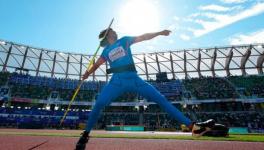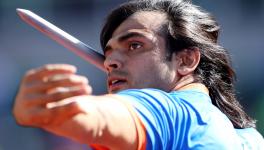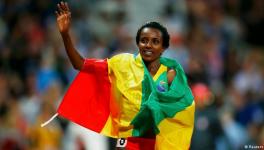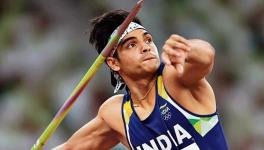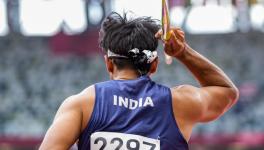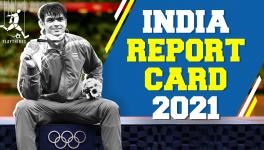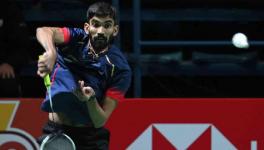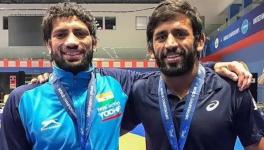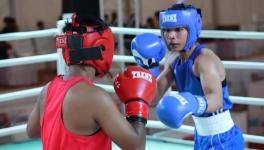IAAF World Championships: The Indian Athlete and the Spinning Vortex of Failure
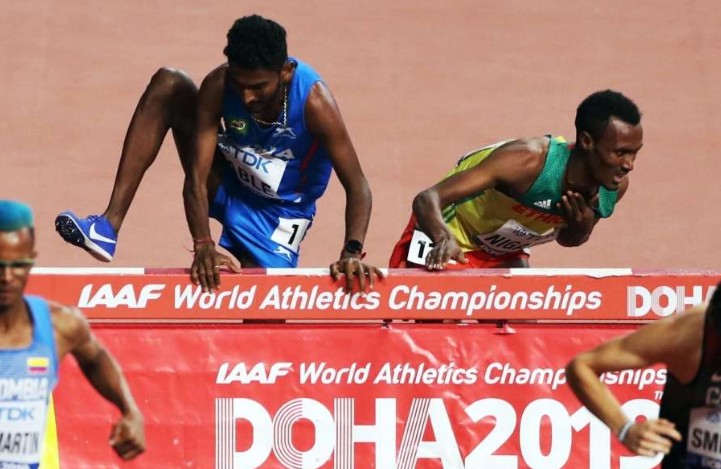
Despite falling in the heats, Avinash Sable (left) made it to the final and broke the national record in the 3000m steeplechase, earning a berth for the Tokyo Olympics (Photo: Doha 2019/Twitter).
What constitutes a successful World Championships for India, I ask the athlete on the other end of the phone. The answer is complex. There are no medals involved and the smoke screen, of personal bests, season bests and national records, fails miserably at obscuring what could be called the futility of an Indian athletics campaign on the world stage. The IAAF World Athletics Championships, that wind up in Doha on October 6, serve as a prime example.
“We try to reach the finals,” the athlete, who has been part of the Indian team set-up for nearly a decade, responds. “It would be a great success if we reach the final. We always try to break our personal bests, and the national record, and that drives us too.”
By that measure — with just two individual athletes making it to the final, and breaking national marks, and the much talked about 4x400 relay quartets not making it to the summit races — the Indian campaign at Doha 2019 was underwhelming.
The conversation with the athlete — a multiple national champion hurdler — turns towards specific performances in Doha. We start with Jinson Johnson, the Asian Games 1500m champion and national record holder, who turned in a time almost four seconds slower than his best in the heats in Doha. It is a question that has always intrigued me — how do Indian athletes motivate themselves when they take to the track or field knowing a medal is beyond their grasp? How does one better oneself while racing toward an inevitable defeat? I was seeking a window into the complex psyche of an elite Indian athlete who, by the time he or she reaches prime, has to have both the mindset needed to be a gold medal favourite on the continental stage and also a backmarker striving for personal benchmarks when on the global stage.
Also Read | Support for Half-truths in Gaurav Gill’s Arjuna Award Application Shows Motorsport Body’s Desperation
No doubt, the mental game is taxing, though the athletes, and even their mentoring and coaching bandwagon, act oblivious to the implications. Perhaps they are unaware. Perhaps they are blinded by immediate priorities. The mental science of performing in the face of failure is more complex than fighting for an outright victory, after all.
An Indian athlete’s journey in a world championship year begins with a burning desire to earn a ticket to the biggest stage in their sport. Late March is when the stars — Salwa Eid Naser, Noah Lyles, Shelly-Ann Fraser Pryce, the Ethiopian middle distance brigade et al — chart out the upcoming months, and tread onto a best possible path towards peaking around the time of the worlds. Around the same time, the Indian athlete begins the long and arduous journey of touching the qualifying mark which, more often than not, requires breaking a national record.
There is no hint of desperation at this point. The training is on schedule, foreign tours (many include competing in obscure meets in Eastern and Central Europe) begin, for exposure. Desperation sets in as the window for qualifying inches shut. On the national circuit, under familiar conditions where variables can also be aligned optimally, a few make the cut. A few more make the benchmark abroad, on the IAAF circuit or at small European meets.
It is evident that the motivation, training, and the mental algorithm of performance for an Indian athlete through the season is primed toward achieving the holy grail of qualifying, and not engineered towards peaking in major competition. The rest should all be a build up towards that peak.
Ever wondered why most of our athletes go drastically below their personal bests at the Worlds, when they were seemingly going faster, hurling projectiles further, or leaping higher a few weeks prior to that? Well, the answer lies in the great Indian journey towards the qualifying mark which leaves many injured, and the fit ones fatigued. So much so that, by the time the big stage arrives, they are past their peak for the year. Johnson, Tejinder Pal Singh Toor, Dutee Chand even… In fact, except for Annu Rani (qualified for the javelin final with a new national record of 62.43m and finished eighth) and Avinash Sable (qualified for the Olympics in the 3000m steeplechase after finishing 13th among 16 finalists) everyone performed below their season best.
Most of the Indians who went to Doha had their backs to the wall a few weeks prior to the World Championships. They were unsure of their tickets and were performing under tremendous pressure. Hima Das’ back, literally, gave way. Neeraj Chopra (the one realistic medal prospect for India at the worlds) is nursing a long-term elbow injury. The rest of the runners, throwers and jumpers, who had their bodies intact for Doha, seemed to carry mental injuries.
Fighting for dear life might work for the military. Desperation may, at times, work in boardrooms. Setting targets and pushing one’s motivational envelope through desperation is detrimental in professional sport, which needs a measured and systematic approach towards setting targets. Desperation also gives seed to doubt, a doubt in their own ability, the foremost.
Also Read | Indian Cricket Ushers in a Revolution Amidst Call For Change
And for elite athletes, nothing is more dangerous than self doubt. It can trigger a domino effect on the psyche.
All of this represents a very bleak scenario. Our athletes may be hitting the world stage mentally taxed, if not fully washed up. And, while at the championships, reality kicks in too. Jinson’s case is a classic example. He was in the top five until the final lap of his 1500m heats. After the bell, it seemed the 28-year-old misjudged his pace and faded. He eventually finished 10th and failed to qualify.
I was presented with a different take on this during the phone chat mentioned earlier. “It was not that Jinson slowed down,” came the explanation. “The others got faster and he could not match the pace. And during overtaking, his strides were getting blocked too which perhaps hindered his rhythm. While running in competitions up to the Asian level we Indians can run at our own pace and rhythm. All that goes for a toss at higher competitions and that is what happened with Jinson.”
The “block” mentioned here has two dimensions. One is the obvious physical hindrance that upsets the natural gait and rhythm of the athlete who is being passed. The other is the mental block the athlete hits when he sees the field surging past, despite his best efforts. Many athletes have described such state of being as the same as running with weights tied to their ankles.
Johnson, however, insists he never reached a point where dejection caught up with him in the race. However, it did dawn on him mid race that he was not in the same league. And the journey towards improvement needs regular, high-level competition. He also shed some light on the highly cerebral world of mile racing where, to match the strategic games at the highest level, he needs to be stronger and faster.
“I began strongly. I was fast. But to progress to the next round, I needed to run in the 3-minute, 35-second range, at least,” Johnson says. “As you know, I barely made it to the World Championships touching 3:35. So there was no way I could match the pace, and as the race hit the final stage, the rest picked up and I was drained. I am more disappointed than any of you guys about this performance. More so because this experience, valuable as it is, has given me a perspective as to where I stand and what I need to do to try and be up there with the best. Simply put, people who barely make it to the world championships can never make a mark there. The people I raced against in Europe [earlier this year] are never here at the Worlds. They never made it to the national teams of their respective countries. That’s the level we are talking about.”
Johnson’s mid-race epiphany was brought about by a heady mix of the mental game and physical struggle. He would have felt every bit of pain over the last 300 metres of the race. It would have reminded him of the long season that saw him better his own national mark. For perspective: Johnson finished his Doha heat in three minutes and 39.86 seconds. His personal best, the national record, is three minutes and 35.24 seconds. If Johnson had matched, or even come close to, this time he would have comfortably qualified for the semifinal race.
Video | Playing for Tomorrow: The High Flying Indian Under-16 Boys Football Team
Shortsightedness in the Indian team’s approach is also evident in how the Athletic Federation of India (AFI) honchos decided to manage Muhammed Anas, the 400m national champion. Anas, who qualified for the individual race with a national record earlier in the year, was kept away from it to keep him fresh for the relays. After all, lucrative spots for Olympic 4x400 competition were up for grabs in Doha — teams making the final earned a ticket for Tokyo. Needless to say, both the teams failed to progress.
Anas’ rare chance to compete against the best in the world, and perhaps grow from the experience, was forsaken. It didn’t matter. One can easily guess the logic of the thinktank: Anas can strive for personal bests or national records (the default individual target of Indian athletes at the world championships) in the qualifying cycles for the big events next year.
That, more or less, sets into motion the next revolution in the vicious cycle that seems destined to continue, trapping Indian athletics in a vortex of mediocrity, that we have learnt to accept as norm.
Get the latest reports & analysis with people's perspective on Protests, movements & deep analytical videos, discussions of the current affairs in your Telegram app. Subscribe to NewsClick's Telegram channel & get Real-Time updates on stories, as they get published on our website.










